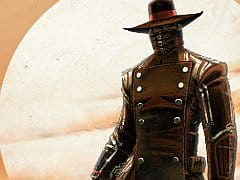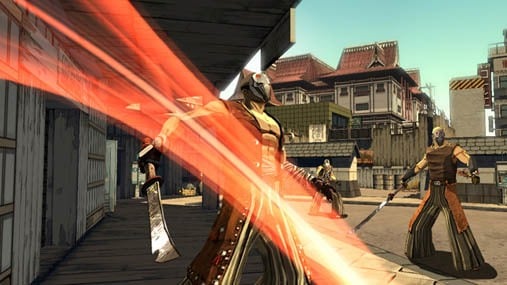You can trust VideoGamer. Our team of gaming experts spend hours testing and reviewing the latest games, to ensure you're reading the most comprehensive guide possible. Rest assured, all imagery and advice is unique and original. Check out how we test and review games here
Putting aside, for a second, the fact that proper 1:1 waggling is what we all thought we were getting with the Wii in the first place, Nintendo’s Wii MotionPlus supposedly makes possible a dream long held by boys who love their toys: virtual sword fighting. Red Steel 2, which only works if you’ve got one of Nintendo’s curious cuboid peripherals plugged into your Wii Remote, sets out to be the game that finally makes that dream a reality. The result – predictably – isn’t quite as good as we’d hoped. But it’s a right blast, all the same.
Usually at this point in a review of a sequel we start going through what’s new and what’s better. With Red Steel 2, however, there’s no point, because it bears so little resemblance to the Wii launch title that you’d think no-one at Ubisoft Paris had played it. In Red Steel you played Scott Monroe, who found himself embroiled in a Yakuza-fuelled thriller set in contemporary USA and Japan. In Red Steel 2 you play the mysterious, silent Hero, a samurai cowboy plunged into a sci-fi Wild West clan war with only his superhuman sword skills to save him from death in the desert. There are no links to the past. No revisited themes, settings or characters. It feels, for all intent and purpose, as if Ubisoft Paris has wiped the bad memory that was Red Steel from its brain and started over.
Still, Red Steel 2 is unmistakeably Red Steel’s follow up. It betters its predecessor’s failed fusing of first-person shooting and sword fighting in almost every way. It’s meaty, mostly responsive, and hugely satisfying. Transitioning from slicing and dicing to shooting is seamless, and combos and finishers flow into each other with the fluidity normally associated with third-person hack and slashers. Some of the attacks are positively brutal; point blank headshots and savage stabbings are Red Steel’s bread and butter (which makes the lack of blood all the more jarring). The game does a great job of making you feel as cool, slick and powerful as you’d imagine the greatest samurai cowboy to ever walk a sci-fi Wild West world would feel, if such a being and such a place were to exist.
It works like this: shooting is a simple case of pointing the Wii Remote and pulling the trigger, but any slicing or stabbing action instantly draws the sword in front of the camera and mimics the angle and power of your real world strike. In this sense, Red Steel 2 simulates that motion controlling holy grail: 1:1 movement (albeit with a little bit of lag and flaky precision). You can twist the remote and the in-game sword will twist accordingly – although doing so has little bearing on combat. But it is only the illusion of 1:1 movement. The game is still translating your motion into an on-screen attack. You can’t, for example, turn the Wii Remote around and stab yourself in the belly. But Red Steel 2 does do waggle-based sword fighting better than any game before it, and that’s good enough for us.
Your strikes are registered as being horizontal or vertical, and quick or powerful – and you need to make sure you’re performing the right combination in order to counter the impressively varied and relentless enemies. Holding the Wii Remote horizontally causes Hero to hold his katana horizontally. Holding the Wii Remote vertically causes Hero to hold his katana vertically. In this way, Red Steel 2 actually has sort of realistic blade blocking; horizontally holding the Wii Remote and holding A blocks vertical strikes, and, conversely, vertically holding the Wii Remote and holding A blocks horizontal strikes. When you nail the timing and start to block attacks with joyous abandon, you really do feel as if you’re actually wielding a katana.
Supplementing these player-mimicked attacks are more traditional command-based Hidden Strikes and Kusagari Powers. Holding A and B and thrusting downward, for example, triggers The Bear, which slams your katana into the ground and stuns enemies in an area of effect. Tapping left or right with the stick and pressing A, then slicing horizontally in a wide arc, performs the Matador – great for quickly getting behind enemies who have strong front defence. Thrusting the Wii Remote and the Nunchuck forward while holding A triggers the Tiger – the katana is held horizontally for a second and glows gold; any enemy attack that hits your blade while in this state causes a stun parry, giving you the opportunity to do some damage. Red Steel 2’s combat system is surprisingly deep, and requires quick reflexes and perhaps more physical effort than any game in the Wii’s short history. After a session, expect aching arms.
The Hidden Strikes and Kusagari Powers have nothing to do with mapping your movement on screen. Instead, they’re all about registering your input, whether it’s back and A then a wide arc slash, or double tap A then downward thrust. These attacks, while meaty and satisfying, remind you that, despite the Wii MotionPlus, you’re playing a video game based on translating button presses and motions into in-game animations. This isn’t a criticism, more an observation that Red Steel 2 isn’t a sword fighting simulator.
The combat’s only let down by the occasional bout of unresponsiveness, lag, and frustration. The MotionPlus can’t save Red Steel 2 from lapses in concentration. Sometimes as you frantically slice downwards trying to trigger a finisher, you get the impression that the game is off on holiday laying out on a deck chair catching some rays. Towards the end of the game, when you find yourself going up against loads of enemies at once, some of which move very quickly and skilfully block your attacks, the waggling makes you want to tear your arms off just so you have something to throw at the telly. And, while you get used to having to move the camera by pushing the pointer to the edges of the screen, you can’t help but long for dual analogue stick controls. The precision on offer here is good – for a Wii game – but the Wii’s single stick control scheme simply can’t compare with dual stick offerings.
Job done, then, with the combat. And job done too with the visuals. Red Steel 2 is a gorgeous hodgepodge of various influences, including the cel-shaded Borderlands, gory anime Samurai Jack and the superb science fiction western TV show Firefly. The Wild West environments, while mostly deserted, look superb, as do the many enemy variants (gimp samurai included). Overall, there’s an attention to detail and a vibrancy that really catches the eye. Red Steel 2 looks lovely. At times, it even looks stunning – head and shoulders above the usual muck we get on Nintendo’s casual-focused console. The audio work is also superb, particularly when frantic action ends and quiet exploration begins – classic Wild West twangs and wistful pan flutes compliment the shrieks of dying ninjas. We even see and hear tumbleweed blow through dusty streets, and the rapping of wooden windows flapping in the wind.
The only thing letting Red Steel 2 down – and this is a big thing – is the world. The pacing of the game is quite deliberate: loud, quiet, loud, quiet, or, combat, exploration, combat, exploration. The quiet/exploration parts of the game are often boring, with nothing more than the destruction of crates, bags, barrels, more crates, bags, barrels, and then, when you think there can’t possibly be more crates, bags, and barrels to destroy, you arrive in a deserted town packed with even more crates, bags, and barrels. It is not an exaggeration to say that by the end of a run through of the campaign you’ll have destroyed over a thousand crates, bags, and barrels. This, obviously, is hard work on the arms.
In fact, more of your time is spent smashing stuff up than smashing people up. ‘Just don’t do it’, you say. Well, you kind of have to, if you want to better Hero. Inside all of the breakable boxes and collapsible crates is cash. Dollars, to be exact, which you spend on the surprisingly deep upgrade system. You need thousands to learn new strikes, extend your health bar, improve your armour, buy new guns, and generally upgrade Hero to the nines. There’s a lot to learn in Red Steel 2, and it doesn’t come cheap. So, yeah, you need to spend the time smashing everything and anything that looks smashable, and it often feels like hard work.
You’d think that it would ruin the game. But it doesn’t. In a weird way, it fits in the odd, very old school game structure Ubisoft Paris has sculpted. Missions are picked up from Sheriff’s boards located in buildings that act almost like safe houses. From there, you set out into the dusty outside and, simply, complete them. While the missions are repetitive and often amount to little more than fetch quests, Red Steel 2 does a great job of whisking you along at a breezy pace. The mini-map guides you along the main story quests effortlessly, but you’re always encouraged to explore, if, for nothing else, to complete the side quests which reward the player with great wads of cash. And cash, remember, buys new toys and special moves to play with: Red Steel 2’s greatest joy.
The somewhat dour exploration is punctuated by the stabby stabby shooty shooty combat so violently that each set-to often feels like a Devil May Cry arena scrap. You walk into an area, enemies spawn, and you need to kill them all before you’re allowed to progress. It’s basic in a game-ey way, but reassuringly familiar. Yes, at times Red Steel 2 feels like a soul-destroying slog through empty, lifeless environments. But the juvenile pleasure gained from stabbing mini-gun-toting samurai in the face does enough to keep you going.
If Red Steel 2’s campaign doesn’t sound like your cup of sake, then Red Steel 2 won’t be for you. Beyond its ten or so hours of fun, there’s nothing else to keep you interested. I suppose you could always try the Challenge mode, which lets you play each level individually with a view to getting a high score, but after the game ended I didn’t feel the need. Two-player co-op split-screen, or even two-player split-screen duels, ala Wii Sports Resort, seem like a missed opportunity.
Despite its flaws, Red Steel 2 is one of the best action games on the Wii. It’s a gamers’ game, with old school mechanics some will find tiresome (mentally and physically), and control issues guaranteed to frustrate. But it all comes together to work well, which is the most important thing. Red Steel 2 doesn’t quite nail perfect 1:1 motion controlled sword fighting, but it points in the right direction.

/https://oimg.videogamer.com/images/783d/red_steel_2_19.jpg)
/https://oimg.videogamer.com/images/4631/red_steel_2_17.jpg)
/https://oimg.videogamer.com/images/c50e/red_steel_2_10.jpg)






